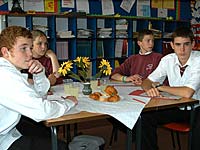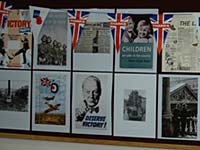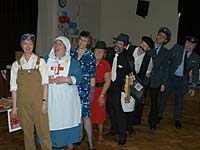
Home Page Project ListingsProject OverviewBackground / ContextLearning ResourcesUseful Links |
Rising Brook V-Thanks ProjectThe SchoolRising Brook High School is an 11-18 High School to the Southern edge of Stafford. It serves the local community and has recently been designated Specialist Sports Status. During the year 2005 all of Year 9 were involved in a project to commemorate and re-live the events of 1945 to coincide with the 60th anniversary of the end of World War II. Altogether around 100 pupils, including some Sixth Form, 20 members of staff, members of the Staffordshire Regiment Army and 5 War Veterans were involved in the Project. AimsThe overall aims of the Project were to encourage Y9 pupils who were studying World War II as part of their History syllabus, to investigate the impact that the Second World War had on the lives of those who lived through it through engagement and interaction with veterans, by visiting the Imperial War Museum in London to experience interactive exhibits and to re-create a realistic World War II experience in school using staff, the Army and other volunteers. Activities
In February 2005 Y9 pupils visited the Imperial War Museum in London and participated in the Blitz Experience as well as viewing exhibits and artefacts from the time of the Second World War. They used a Secret Code worksheet to follow a trial on a special D-Day exhibit to work out a secret message. In subsequent follow up work in class some of these experiences were reflected upon and built into lesson planning. A small group of 8 Y9 pupils then undertook to find and interview War Veterans about their experiences. Using a Pensioners Lunch Club in the school, with some help from their teacher (me) we persuaded the reluctant pensioners to talk about their experiences and these are recorded in Appendix One. A reporter from the Express & Star newspaper became interested in this project and interviewed these pupils resulting in the first of two articles appearing in that newspaper. As a result of links through the ‘Their Past, Your future’ project at the Imperial War Museum, we were contacted by another War veteran in the area, who in November 2005 came to give a talk to the same Year group who were studying History GCSE (by now in Y10) .
The final part of the Project was a V-Thanks Day on Friday 8th July, timed to co-incide with national V-Thanks Day, in which 100 Y9 pupils undertook a number of themed activities involving map-work, rationing, marching, being evacuated, taking part in an escape plot (in French) and mass singing!! The 181 AYT Army team from Lichfield Barracks led square bashing and parade drill and all staff who took part (including the Headteacher) dressed up in costume specially hired for the day. Needless to say, press coverage was extensive and a large photographic display from the event provided the centrepiece of Open Day for the School, occupying pride of place in the foyer. OutcomesIt is impossible to measure the outcomes for pupils in quantitative terms, but feedback from nearly all pupils was very positive and they will all have had an opportunity to experience a simulated World War II experience as well as time for reflecting and learning more about World War II. Some pupils brought in objects and had obviously talked to elderly relatives about their experiences. The group that interviewed the Veterans had a chance to meet and talk to a different generation, with mutual benefit to both, with the pensioners impressed that young people were still interested in finding out about and studying the War and the young people fascinated by some of the recollections, as well as a reluctance on the part of some to talk about it even after all of this time.
The staff who took part, from a variety of subject disciplines, all had a fantastic time, the opportunity to develop a cross-curricular theme related to Citizenship outcomes and relating directly to the Community. They now want it to become an annual event! Ian Wibberley Appendix OneVeteran TestimonyStan was born in Stafford but worked in Reading for most of the War years. He left school at 14 and went to work for an engineering company. At first they were making bicycle parts but then they switched production in 1940 to making the tips of the wings for Spitfires. Apparently they kept splitting and falling off when the plane was landing because they were not strong enough. The new wing tips were wooden and had to be taken to the nearby Spitfire factory to be fitted. Stan would cycle with them and was worried that if he dropped one and they split then the foreman of the Spitfire factory would shout at him! At first there was little bombing in Reading, presumably because of the Phoney War, but then the air-raids started. The siren would go when the planes came over the coast and everyone would have to go down the air-raid shelters. Stan reckoned that the Anderson Shelters were quite good, but could not survive a direct hit. One day his friend at work did not appear-his house had taken a direct hit the night before. Reading was not a main target but the bombers would sometimes drop their load either on the way to Coventry(?) or on the way back. At first the sirens would not sound the all-clear until the following morning, but after a while they stopped doing this because no work was being done on the night shift and the workers were too tired to work the following morning. You did not get much sleep in an Anderson Shelter. Later in the War Stan’s factory started preparing for D-Day. They made the flat bottomed boats that the Allies used to land on the beaches of Normandy. These were originally an American design but were made now in Britain. They were launched on the Thames and floated down to the docks (Tilbury?) ready for use by the troops. They sat low in the water and had a big flap that dropped down at the front so that the soldiers could run straight up the beach. Eventually Stan was old enough to join the Navy and was sent to Singapore, but by then it was back in British hands and Stan saw no significant naval action. He later moved back to the Stafford area where he still lives to this day. Two other of his friends who saw action in Palestine were unwilling to speak about their experiences, even 60 years later.
Interview of pensioners by Nicole Brannan, Y9 pupil Rising Brook High School World War II! I bet most of you wondered what happened. On Thursday, 29th of June, I interviewed a man called Tony Wilkinson who was between the ages of 8 and 10 years old when the war first broke out. He told us that everyone about at this time knew that there would be a war at some point. However, 11:00 on a Sunday morning it was made official. The prime minister declared that there was going to be a war with Germany. Interview of pensioners by Amy Watkins, Y9 pupil Rising Brook High School Stafford To help us understand more fully what life was actually like during WW2, we interviewed Mr James Large (82), who was involved in one of the most remembered days in this century, he was involved in D-Day. D-Day was when the British triumphed over the Germans on June 6th 1944. Mr Large was born in Wales but moved to Rugely when he was two because the mines his father worked in were closing. He grew up and began to work in labour, which involved factory work in Cannock. However when he was 18 he was enlisted for the army. He knew the war was inevitable and he knew he would be called up sooner or later because he was at the right age. In 1942 he was eventually called up and was sent with the other soldiers to a camp where they would be tested to see what their strengths and weaknesses were. By Amy Watkins and Rebecca Hughes |



